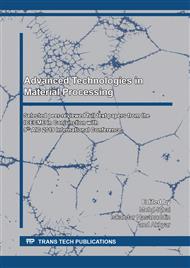[1]
R. Puff, R. Barbieri, Effect of non-metallic inclusions on the fatigue strength of helical spring wire, Eng. Fail. Anal. 44 (2014) 441-454.
DOI: 10.1016/j.engfailanal.2014.05.013
Google Scholar
[2]
T. Tsubouchi, K. Takashi, T. Kuboki, Development of coiled springs with high rectangular ratio in cross-section, Proc. Eng. 81 (2014) 574-579.
DOI: 10.1016/j.proeng.2014.10.042
Google Scholar
[3]
Husaini, K. Kikuo, M. Hanji, N. Mitsuo, Investigations of the mixes mode crack growth behavior of an aluminium alloy, J. of Eng. and App. Sci. 11 (2016) 885-890.
Google Scholar
[4]
T.M. Mulia, S.J. Kadam, V.S. Kengar, Finite element analysis of helical coil compression spring for three wheeler automotive front suspension, Int. J. Mech. Ind. Eng. 2 (2012) 74-77.
DOI: 10.47893/ijmie.2013.1130
Google Scholar
[5]
R. von Mises, Mechanik der festen Körper im plastisch-deformablen Zustand, Nachrichten von der Gesellschaft der Wissenschaften zu Göttingen, Math.-Physi. Klas. 1 (1913) 582-592.
Google Scholar
[6]
S. Ilic, Methodology of Evaluation of In-Service Load Applied to the Output Shafts of Automatic Transmissions, Ph.D. Thesis, The University of New South Wales, (2006).
Google Scholar
[7]
Husaini, T.E. Putra, N. Ali, Fatigue feature clustering of modified automotive strain signals for saving testing time, Int. J. of Automotive and Mech. Eng. 15 (2018) 5251-5272.
DOI: 10.15282/ijame.15.2.2018.8.0405
Google Scholar
[8]
L.F. Coffin Jr., A study of the effects of cyclic thermal stresses on a ductile metal, Trans. of the ASME. 76 (1954) 931-950.
DOI: 10.1115/1.4015021
Google Scholar
[9]
S.S. Manson, A complex subject-some simple approximation, Exp. Mech. 5 (1965) 193-226.
Google Scholar
[10]
J. Morrow, Fatigue Design Handbook, Society of Automotive Engineers, Warrendale, (1968).
Google Scholar
[11]
K.N. Smith, P. Watson, T.H. Topper, A stress-strain function for the fatigue of materials, J. of Mat. JMLSA. 5 (1970) 767-778.
Google Scholar
[12]
A. Palmgren, Die Lebensdauer von Kugellagern, Zeitschrift VDI, 68 (1924) 339-341.
Google Scholar
[13]
M.A. Miner, Cumulative damage in fatigue, J. of Appl. Mech. 67 (1945) A159-A164.
Google Scholar
[14]
nCode, GlyphWorks, nCode International, Ltd., Sheffield, (2018).
Google Scholar
[15]
ASTM A29/A29M-05, Standard Specification for Steel Bars, Carbon and Alloy, Hot-Wrought, General Requirements for, ASTM International, West Conshohocken, (2006).
DOI: 10.1520/a0029_a0029m-04e01
Google Scholar
[16]
K. Do-Hyoung, C. Dong-Hoon, K. Hak-Sung, Design optimization of a carbon fiber reinforced composite automotive lower arm, Composites: Part B. 58 (2014) 400-407.
DOI: 10.1016/j.compositesb.2013.10.067
Google Scholar


